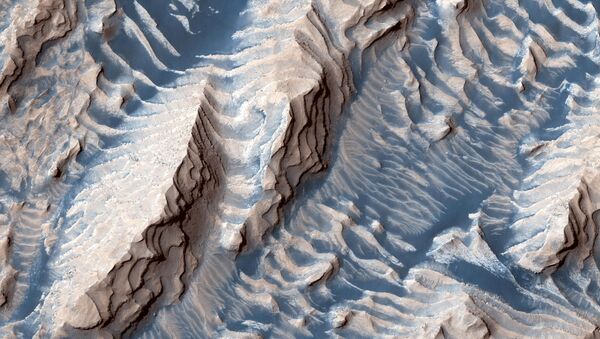Mars is wetter than previously thought but not in a way that would increase its potential for hosting life, a new study published on Monday suggests.
Scientists have long observed possible evidence of liquid brines (super salty water) on the Red Planet, which materialise as dark streaks on warm slopes shown on NASA's Mars Reconnaissance Orbiter.
This image shows dark streaks from flow of briny liquid water on Mars: http://t.co/lp6Der5qbe #MarsAnnouncement pic.twitter.com/4D3isI2zyj
— NASA (@NASA) September 28, 2015
Liquid freshwater can't subsist for long on Mars, as it either freezes or boils away due to the planet's thin atmosphere. Brines, however, have a much lower freezing point due to their salt content and can stay in liquid form for longer periods of time.
Researchers involved in the study used measurements from Mars-studying spacecraft and used information derived from atmospheric models to construct a new model, which allows for predictions of where liquid brines could exist at and near the surface of Mars.
The new model reveals that up to 40% of the planet could support liquid surface brines for up to six hours. This phenomenon is seasonal in nature, with brines only being possible for 2% of a Martian year (687 Earth days) depending on the location, according to the team of researchers.
Mars' near subsurface is likely even wetter, the model suggests. Brines could potentially exist during 10% of the Martian year 3 inches below the surface.
The team claimed that despite the planet containing more liquid than previously thought, it does not raise the likelihood of Martian life.
"Our results indicate that (meta)stable brines on the Martian surface and its shallow subsurface (a few centimeters deep) are not habitable because their water activities and temperatures fall outside the known tolerances for terrestrial life," they wrote in the new study.
However, due to the brines apparently being unable to support Earth-like life, future Mars missions should be able to investigate them without having to be as concerned about contamination.
"These new results reduce some of the risk of exploring the Red Planet while also contributing to future work on the potential for habitable conditions on Mars", study co-author Alejandro Soto, and a senior research scientist at Southwest Research Institute in Boulder, Colorado, said in a statement.
Scientists believe that Mars once had an extremely thick atmosphere and an ocean which encompassed around 40% of the surface of the planet. After it lost its magnetic field, the Red Planet's atmosphere was stripped away by particles from the sun.


